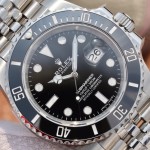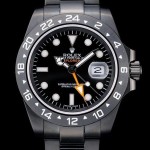The Ingenious GMT Watch – Tracking Time Across Continents
The GMT complication has surged in popularity, and for compelling reasons. It elevates a watch beyond simple timekeeping, offering tangible utility at a price point often more accessible than chronographs. Visually, the additional hand and the frequent inclusion of a rotating, often vibrantly colored, bezel lend themselves to dynamic, sporty aesthetics. Yet, above all, the GMT’s true value lies in its profound relevance to our interconnected modern lives. Let’s delve into the history, mechanics, and enduring appeal of this ingenious watch function. 
Our story begins not in a watchmaker’s workshop, but in the skies. On May 2, 1952, a defining moment arrived: 36 passengers boarded a British Overseas Airways Corporation (BOAC) De Havilland Comet jet and flew nonstop from London to Johannesburg, heralding the dawn of the Jet Age. Airlines like Pan Am rapidly invested in fleets of Boeing 707s and built sprawling terminals like the WorldPort at JFK. Suddenly, crossing oceans and multiple time zones within a single day became possible, bringing with it the novel affliction of jet lag. Pilots navigating these long-haul routes faced a critical challenge: simultaneously tracking local time and the time at their departure point.
The Glycine Airman, introduced in 1953, offered an early solution. Designed explicitly for these aviators, it featured a 24-hour display (avoiding AM/PM confusion) paired with a rotating bezel marked with 24-hour indices to track a second time zone. While innovative and still available today, it wasn’t this watch that captured the era’s spirit. Instead, Pan Am turned to Rolex, the brand trusted by explorers from the summit of Everest to the ocean depths. Their collaboration resulted in the 1954 birth of the GMT-Master, a fake watch engineered to mechanically track two time zones at once.
But what does “GMT” signify? Though Rolex’s implementation was novel, the underlying concept wasn’t new to the 1950s. It traces back to the International Meridian Conference of 1884, which established Greenwich, England, as the prime meridian. Greenwich Mean Time (GMT) became the global reference point against which all other time zones were measured. However, GMT emerged in an era of steamships, where time zones were traversed over days or weeks. Jet travel shattered that pace. By 1955, atomic clocks offered unprecedented precision, leading to the development of Coordinated Universal Time (UTC) by 1960, which effectively superseded GMT as the technical standard. Yet, the name “GMT” endured, forever evoking the pioneering spirit of the Jet Age – a spirit perfectly encapsulated by the sight of a Pan Am captain’s wrist adorned with the first GMT-Master and its iconic red-and-blue bezel. 
The brilliance of the GMT watch lies not in complexity, but in elegant simplicity. A standard watch movement spins the hour hand around the dial every 12 hours. To transform it into a GMT tracker, watchmakers add a second hour hand geared to rotate at half the speed, completing just one circuit every 24 hours. This hand points to a 24-hour scale, instantly clarifying whether the referenced hour is AM or PM. Rolex’s ingenious contribution was the bidirectional rotating bezel, famously rendered in red and blue (“Pepsi”). The 24-hour GMT hand points to this bezel’s scale. By rotating the bezel, any hour can be aligned with the GMT hand, enabling the tracking of any second time zone – echoing Glycine’s concept but achieving wider fame.
Why then the name “GMT-Master”? Pilots, adhering to navigation and communication protocols, universally operate on GMT (or UTC) time to eliminate ambiguity. Those pioneering Pan Am pilots would perpetually set their 24-hour hand to GMT, regardless of their local time. While the Breitling Navitimer chronograph reigned as the quintessential pilot’s watch of the propeller era, its intricate slide rule bezel and busy dial felt increasingly anachronistic as jet travel accelerated in the 1960s. The cleaner, purpose-built GMT-Master ascended as the de facto watch for pilots, fighter jet crews, and astronauts. Its practicality and aspirational allure soon captivated jet-setting travelers beyond the cockpit. Owning a GMT watch signified a life lived across meridians, a passport to the world’s exotic corners.
Early GMT watches operated with straightforward mechanics: the 24-hour hand was fixed to the local hour hand. Adjusting the local time moved the GMT hand in lockstep, effectively displaying the local time on a 24-hour scale. Setting a different second time zone required rotating the bezel. Later advancements introduced independently adjustable GMT hands, decoupled from the local hour hand and the date function, offering greater flexibility. This remains a key distinction in modern replica watches.
Today’s offerings showcase sophisticated evolutions of these principles. Movements now typically fall into two main categories. The first features an independently adjustable GMT hand. This hand can be set completely separately from the local time displayed by the main hour hand and operates independently of the watch’s date complication. The second type links the GMT hand to the local time but allows for jumping the local hour hand in one-hour increments (often via the crown), enabling rapid adjustment of the primary time zone while the GMT hand (usually set to a home time) remains constant. This functionality is particularly valuable for frequent travelers crossing time zones. Whether displaying a home time, tracking a crucial business hub, or simply connecting with loved ones abroad, the GMT complication endures as a remarkably practical and evocative feat of horological engineering, a direct link to the thrilling dawn of global air travel.





